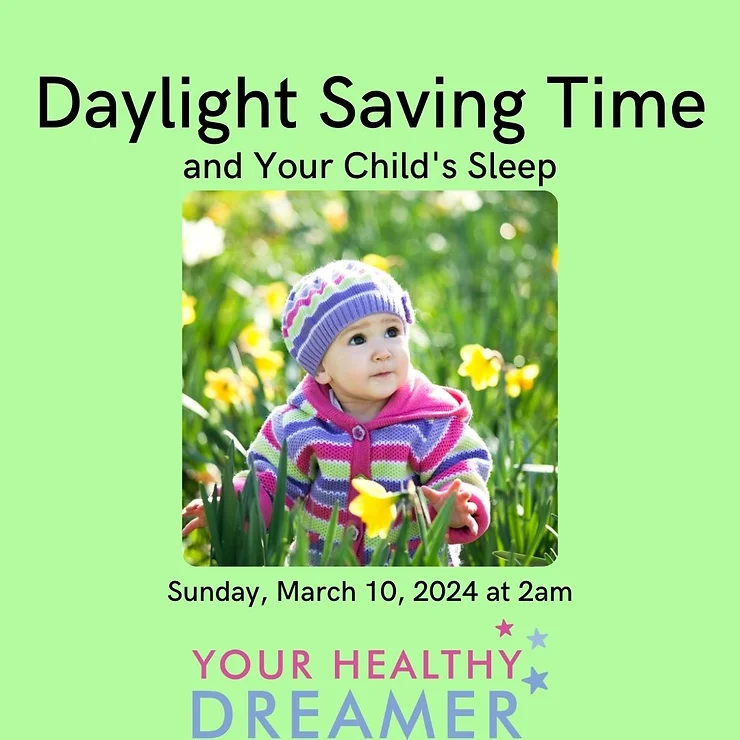Daylight Saving Time is beginning soon on Sunday, March 9, 2025 at 2am. That 2am is going to turn into 3am and that one beautiful hour will be gone for a long while – with plans to come back at 2 am on Sunday, November 2, 2025 to mess things up in a slightly different way 🙂
For now, it means progress toward more sun in the evening, and more darkness in the morning. Most people like this part!
Still, when the clocks change, it does disrupt our natural body clocks, or circadian rhythms. Some of us are highly adaptable and barely notice the change, while others can feel a bit off for several days to a week. The same goes with our children.
Here are my top 5 tips on how to best manage this transition with your children.
Top Five DLS Tips!
ONE. Teach Sustainable Healthy Sleep Skills before DLS to equip your babies and children with the skills to attain all of the high-quality sleep their growing brains need to thrive to their fullest potential. Children who have the confidence and ease of putting themselves to sleep at bedtime and when they wake during the night, are more likely to be well rested at baseline. Well rested children tend to be more adaptable to minor schedule or routine changes.
TWO. Get Outside! Circadian rhythms need to adjust, and exposure to direct sunlight is going to be the most efficient and direct way to assist in this transition. Get your little one outside as much as possible during wake times to help their little brains recognize the clear difference between the light that is present during daytime play and the absence of light that is present during sleep times.
THREE. Take Steps to Ensure the Most Conducive Sleep Environment. This means the room is safe, boring, cool, quiet, and dark. Is there any light coming into your child’s sleep room? Block it entirely and then bask in the joy when you see how much easier they are going to fall asleep and stay asleep in a truly blacked out room.
FOUR. Keep Your Routines Around Sleep Very Consistent. Your lovingly simple but extremely predictable bedtime and pre-nap routines should be a constant no matter when exactly sleep times land. These routines keep our kiddos feeling safe and secure, and ease transitions from wake to sleep even amidst big changes.
FIVE. Update Sleep Schedules Accordingly. When times change, it can often lead to missed sleep. When children don’t catch up on lost sleep, they can easily fall into a negative sleep cycle that leads to an overtired child with regular sleep disruptions. Let’s plan to stop that scenario from unfolding.
Here are two different scenarios:
Scenario Number 1: For the Child who Needs to Wake Up Early
If your child needs to wake up at a certain time to start your day, recognize that they will have lost one full hour of sleep that night. Babies who are on a two or three nap schedule will need to be awake by 7am in order to build enough sleep pressure for their morning nap. Older children may simply need to start their day earlier for daycare or school come Monday. Due to the missing hour when we “Spring Forward”, they will lose out on one hour of sleep.
We can’t just forget about that precious hour of sleep. We need to offset the deficit and ensure your little one catches up on their sleep to minimize future sleep issues. The best way to do this is with a temporary extra early bedtime. Shift bedtime 15-30 minutes earlier than usual for 1-3 days. Problem solved 🙂
Scenario number 2: For the Child Who Already Wakes Too Early
If your child is usually waking up a bit earlier than necessary despite their strong independent sleep skills, then this might be a helpful little push in the right direction toward later mornings! Allow your child to sleep in on March 10, which is likely to be about 1 hour later than usual (as long as that sleep environment is truly on point). Then proceed as usual based on the clock.
Daylight Saving Time is a pain because we have to re-set our natural body clocks and assist our children in re-setting theirs as well. It can absolutely result in sleep disruptions simply because it’s a change. If your child is demonstrating some minor sleep issues, use the tools listed above and know that they will resolve within a week as long as you are able to hold those lovingly firm boundaries around sleep.
If sleep for your child is often a challenge, read more about my top 5 healthy sleep tips for babies, toddlers, and preschoolers.
Lastly, if you’re interested in working one on one with a comprehensive and fully personalized sleep plan to meet the needs of your family and unique child I invite you to read more about the sleep services I offer and to schedule a free 15 minute discovery call.

